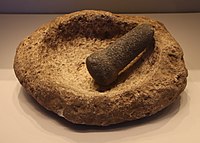Nahal Oren (archaeological site)
Hebrew)/Wadi Fallah (Arabic), Mount Carmel | |
| Region | south of Haifa, Israel |
|---|---|
| Coordinates | 32°43′N 34°58′E / 32.717°N 34.967°E |
Nahal Oren is an archaeological site on the northern bank of the
Upper Paleolithic
This section is empty. You can help by adding to it. (November 2019) |
Grain
Wheat was recovered from the Nahal Oren site, but it was not certain whether it was cultivated or wild. Grain was relatively rare at the site in comparison with other food resources.[1] The age of the emmer wheat grains found there is an indication that the cultivation of grain might have started as early as 16,000 years ago.[3] In 1985 the three spikelets of cultivated emmer found in a Kebaran context in Wadi Oren were seen to be so early as to be considered an anomaly. [4][dubious ]
Neolithic village
A PPNA village of some 13 subcircular houses and other structures stood on four artificial, closely set terraces. The buildings were similar to those of PPNA Jericho.[2]
Only one human burial was discovered at the PPNA village site. There were no grave goods in the burial pit, and the skeleton was complete with the exception of the skull, which had been removed - an early example of a practice better known from the later Neolithic.[2]
The remains of the
-
Skeletons from Nahal Oren (Miriam Stekelis Museum of Prehistory, Haifa)
-
Mortar and pestle from Nahal Oren, Natufian, 12500-9500 BC.
-
Basalt sharpening stones,Eynan('Ain Mallaha) and Nahal Oren, Natufian Culture, 12500-9500 BC.
Domestication of gazelles and goats
During Neolithic occupation, the main source of food at the site appears to have been gazelles, and judging from the high incidence of immature gazelle bones, these animals were domesticated.[1] The later shift to goat husbandry may have occurred because goats are less selective in their diets than gazelles, and can graze in areas where the gazelle would not fare well.[1]
Repeated occupation
Nahal Oren was occupied repeatedly over thousands of years by culture after culture, which means that it was a preferred site for occupation, rather than an occasional one.[1]
External links
- Israel Museum, Jerusalem. Items found at Nahal Oren
- Bible Walks, Oren Caves; non-academic, with many photos and useful information
See also
- Ohalo II, a Kebaran (Upper Paleolithic) site at the Sea of Galilee containing the earliest identification of emmer wheats
References
- ^ a b c d e f g A.M.L. Moore, The Neolithic of the Levant, Oxford University, 1978
- ^ a b c A.M.L. Moore, The Neolithic of the Levant, Oxford University, 1978. Chapter 2 (pp. 99-106). [1]
- ISBN 9781594777837. Retrieved 27 January 2017.
The recent and totally unexpected find of several grains of morphologically domestic emmer wheat at the Palestinian site of Nahal Oren also rises the possibility that grain was under cultivation as early as 14000 BC.
- ISBN 0-444-42703-1. Retrieved 27 January 2017.)
The very early site for cultivated emmer at Nahal Oren is, at present, an anomaly, but could be real. Three spikelets were found sealed under a rock fall in Kebaran context. The morphology is that of a cultivated race....
{{cite book}}:|work=ignored (help - ^ A.M.L. Moore, The Neolithic of the Levant, Oxford University, 1978. Chapter 4 (pp. 218-221). [2]



